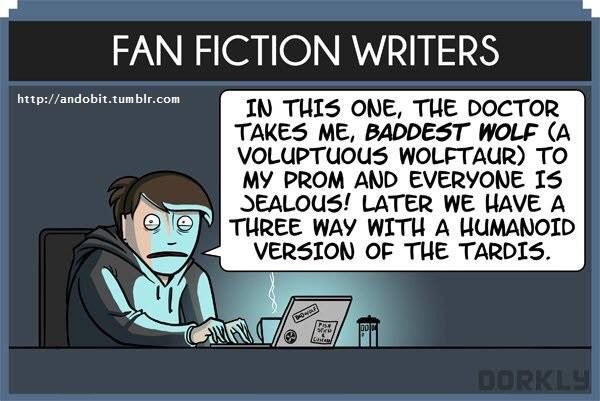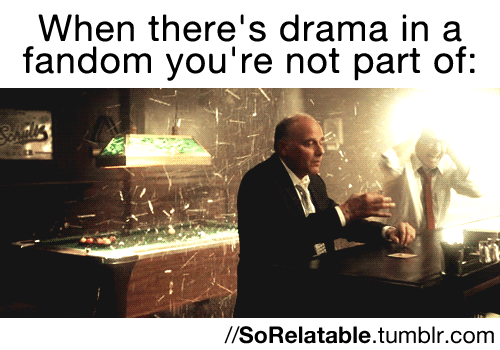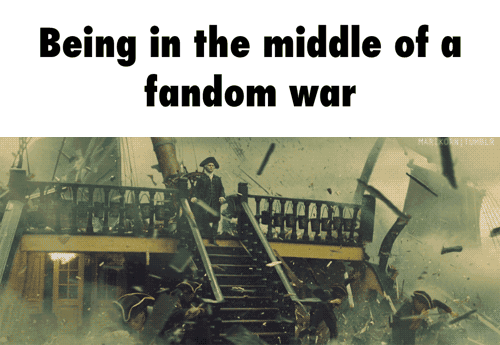The basic definition of the two is fandom that is practiced in one of two ways by either collecting information about the source material, or transforming/changing the source material to best interact with it. Sometimes there is a degree of overlap, but the motivations for the overlap tend to differ. Male fans generally engage in curatorial fandom, where the degree of fandom is noted by how many details of the source material can be collected and/or memorized, from figurines, to dialogue, to plot details. There is sometimes quantification involved such as rankings and listings. See those YouTube videos and posts that list episodes in a series from best to worst, or movies in a franchise. Curatorial fandom does not require intimate engagement with the material. One example is the movie Endgame, where male fans got caught up on attempting to parse how the Time travel worked in the movie, while female fans on Tumblr wrote meta-analysis about the different character’s psychology and emotions.

Transformative fandom, as primarily practiced by women, involves a deep interaction with the source material, along with the collection of details for transforming the source material into something else, usually something that resonates with that particular fan, such as cosplay, fan art, fan fiction, and meta- analysis.
This is not a hard and fast rule, as there can be some degree of overlap. There are plenty of men involved in cosplay, fan art, and meta-analysis, and there are plenty of women who memorize dialogue, and collect information about their favorite shows.
Transformative fandom seeks to change the source material to reflect its needs, or analyse the source material for why those needs aren’t being met, and how it could. One of the tenets of Curatorial fandom is that it doesn’t question the source material, simply accepting it. Having not been the primary audience for much of the source material of many fandoms, Transformative fandom this is mostly, but not exclusively, engaged in by PoC, LGBTQ, and White women.
It has been speculated that one of the reasons white male fans have been reacting in fandom the way they have is that Curatorial fandom is in opposition to Transformative fandom, which seeks to change the canon source material, thereby making the collection of facts and figures obsolete or irrelevant. Such men have defined their fandomhood, sometimes their very identities, by the amount of knowledge they possess about their particular fandom, and in their minds, Transformative fandom seeks to arbitrarily, and unnecessarily, change it. So, beyond the idea that they are no longer the audience for the material (something which is not ever going to change) is the false idea that female fans are taking the material and making random changes to it in the form of fanfiction and fan art. Helping matters along is that Speculative and Fantastic fiction is becoming more diverse, with creators changing the canon sources themselves by changing characters to women (Thor), stating the sexual orientations of older characters (Iceman), or making other characters PoC (Candace Patton as Iris West.)

https://fanlore.org/wiki/Curative_Fandom
Curative fandom is all about knowledge. It’s about making sure that everything is lined up and in order, knowing how it works, and finding out which one is the best. What is the Doctor Who canon? Who is the best Doctor? How do Weeping Angels work? Etc etc. Curative fandom is p. much the norm on reddit, especially r/gallifrey. Transformative fandom is about change. Let’s write fic! Let’s make art! Let’s make a fan vid! Let’s cosplay! Let’s somehow change the text.
Transformative fandom seeks to interact on an emotional level with the source material. It wants to question it, and work within it, which is why so much of it centers on characters and relationships between the characters, while taking place in different environments. I know plenty of people consider Coffee Shop AUs to be cliche, but it is a way for female fans to self insert, while analyzing the characters, by changing the environment in which the story takes place. It is not about removing dramatic impetus from the source, but understanding who the characters are, how they interact, and giving themselves the happy endings that so much of the source material in Fantastic fiction disdains. Its also a way for marginalized people to imagine themselves in source material in which they are not represented. The Mary Sue, the Self Insert, and Shipping, are all attempts by Transformative fandom to interact personally with the source material.
If Curatorial fans ,who are well represented in the source material, imagine themselves as being one of the characters in it, then Transformative fans like to imagine interacting with the characters in it. Its not so much that they want to be Buffy, or Willow, but self inserting as a friend of Buffy, gives such fans a way to express their love and affection for any of the other characters she may interact with in the show, like Spike, Anya, or Giles. Or putting themselves in the situations the characters encounter. many of the tropes of fan fiction come from female fans imagining what they would do if they found themselves within the source material, like defeating the villain, having love affairs , or offering comfort when their favorite characters are in pain.

https://www.vox.com/2016/6/2/11531406/why-were-terrified-fanfiction-teen-girls
My preferred explanation is the idea that the vast majority of what we watch is from the male perspective – authored, directed, and filmed by men, and mostly straight white men at that. Fan fiction gives women and other marginalised groups the chance to subvert that perspective, to fracture a story and recast it in her own way. … It often feels as if there isn’t much space for difference in the dominant cultural narratives; in fandom, by design, there’s space for all.
Another issue is the devaluation of women’s interests and hobbies. Because Transformative fandom is mostly engaged in by women, there is a tendency to disregard it, along with its problems. There is also a certain level of mockery and disgust, whereas the same level of disgust is not aimed at, for example, men’s sports fandoms, which can be far more violent. Narratives aimed at a female audience, or interests and hobbies of women and other marginalized people are often disregarded, the way movies aimed at Black audiences were often disregarded or considered of no importance by White audiences. Don’t believe me? Name the top three favorite films in the Black community. From before 2000!
What is not often discussed, and this is where devaluation comes in, is that Transformative fandom also has its contingent of harassment and bigotry, but because its women, its less obvious than the harassment engaged in by Curatorial fans, dismissed as not being important, and mocked as fans just being crazy. Bigotry in Transformative fandom changes source material that may actually be progressive, to reflect the mainstream status quo, by erasing women of color from canon relationships, or abusing Black male characters, by writing them into slavefic. When WoC question and/or analyse the source for racism and misogynoir, they are often harassed, gaslighted, or shouted down by White female fans. When Gay fans question the fetishizing of mlm characters in fandom, they are often treated the same. There are plenty of white women fans harassing WoC actresses, who happen to be paired with White men in the source material, like the still ongoing harassment campaign against Candace Patton, from The Flash.This is not the type of bad fandom behavior that gets covered in mainstream media, which attributes such harassment only to White men, and as a result, the public tends to think that White women are innocent of it. They are not. They simply have different motivations.

https://newrepublic.com/article/137489/women-color-price-fandom-can-high
The attacks on her character range from obvious bigotry referring to her as a monkey to more subtle remarks about how the two love interests don’t “look good together”. Look through Tumblr, Twitter, or even the recaps on popular sites and you’ll find an inordinate amount of hate toward Iris for things other white female characters get a pass for.
There were plenty of White female fans denigrating Kelly Marie Tran, and her character, before she deleted her Instagram account. The only difference was their behavior wasn’t in the public eye, because they were not attacking the actress directly. They were attacking her fans instead, or engaging in transformative media, in the form of tweets, essays, and fanfiction that erased and/or vilified her character. This is typical in Transformative fandom, where White women deliberately fail to understand, or choose to ignore, intersectional feminism, in favor of uplifting white female characters, while diminishing WoC in both fandom and the narrative.
https://stitchmediamix.com/2018/09/19/what-fandom-racism-looks-like-only-33-words-in-a-trailer/
Hell, did y’all see how the Agent Carter fandom demanded that WOC support a show where we weren’t even vaguely represented – all in the name of feminism – and then blame us for the show doing poorly in its second season? (Or, Tamora Pierce wading in with a totally wrong and racist interjection about 1940s New York must have looked like and what Black people would’ve done in that time period.

There has been a lot of discussion lately about Curatorial fandom behaving badly, while ignoring that Transformative fandom often behaves just as badly, but because the perpetrators are White women, who tend to be more subtle in their practice of it, whose interests and hobbies tend to be devalued, and who have traditionally always been seen as innocent of bigoted and racist behavior, this gets ignored by the mainstream.
Now, this isn’t to say that one form of fandom is better or worse than the other. They are both simply differing ways of being a fan. But that is not to say that Curatorial fandom doesn’t have issues. We’ve already talked about how bigotry and racism from Curatorial fans is covered in mainstream media, but one other issue is that sometimes curatorial fandom does not go beyond collecting information about the source material, and has a tendency to lack depth. Fans may not ask questions, or seek to think any deeper about it beyond simply knowing it in detail, or ranking it from best to worst. That can lead to a certain amount of shallowness , and we’ve already seen that it can lead to gatekeeping, where members of a particular fandom feel a need to test newer fans on their knowledge about it, before being permitted to enjoy that fandom. Since they practice fandom in a Curatorial style, , a lack of knowledge, in their minds, means that someone isn’t a real fan.
Another side effect of Transformative fandom is that fans can get so caught up in their imaginary version of the source material (known as head canon) that they bully and harass others who don’t believe as they do. They will attack other fans, thereby keeping the harassment in-house. This accounts for the many “shipping wars” that are bizarre and puzzling to outsiders, like what happened in the Supernatural fandom, when certain fans became convinced that their imaginary relationship, between Dean Winchester and the Angel Castiel, (called Destiel) was actually a canon relationship being kept from them by the creators. It got to the point where such fans were also harassing the actors, their wives, and the writers, by making fanciful claims about the real life actors relationships with each other and their wives, and bullying those fans who refuted these beliefs.

https://scadconnector.com/2018/04/10/fascination-and-frustration-an-analysis-of-fan-fiction/
Fan fiction is written by people who watch a show or a movie, or read a book, and look at what they are given and think, but what if this happened?
Although there are differences in how fandom is practiced, there is a great deal of overlap in type, and no way of performing fandom is better than another. Both styles of fandom have significant drawbacks, especially when practiced carelessly, by forgetting that other types of fans exist, acting and thinking without regard to other members of the fandom, or even the creators. These are just different ways of enjoying the narrative, and most people engage in at least a little bit of both kinds of fandom. But when people feel threatened by, for example, changes in the source material, or by other fans (sometimes other marginalized fans) who refute their ideas about the source material, the kind of behavior we see is usually based on this divide.
https://www.syfy.com/syfywire/ready-player-one-marvel-and-the-cure-for-curative-fandom
All we have to do to open up curative fandom is incorporate a little more of Column B, shifting the curative focus from “catalog everything in the collection” to “what’s the most interesting thing in here?” By leaning harder into the curatorial roots of curative fandom, Marvel’s hit upon the solution to it.
Or, to put it another way—Ready Player One feels like the past. Black Panther feels like the future.
**This is just my attempt to understand why some fans behave so badly, and yet still refer to themselves as fans, because one of the first things I did was question whether or not these people were real fans, and these essays somewhat answer my question. My definition of fandom wasn’t wrong, it just needed to be expanded to include different performances of it, and that a lot of the behavior we see coming out of fandom is due, at its foundation, to this difference in thinking. This is not to give these people an out for their bad behavior, or an excuse, but for me to understand the psychology behind why people do what they do in fandom, and pass along some of that understanding.
